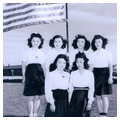After the Japanese bombed Pearl Harbor, the U.S. government interned Japanese-Americans with as little as one-sixteenth Japanese blood, outdoing Hitler, who defined Jewish ancestry as a one-eighth portion. Between 1942 and 1945, 7,657 Japanese-Americans were held in what quickly became the tenth largest city in Colorado. The self-sufficient camp produced a surplus of crops and live-stock. The internees transplanted small cottonwoods and willows from the Arkansas River banks to their bleak concentration camp, where they lived in wooden barracks buildings. They worked in factories and on farms and participated in scrap drives and other activities to help win the war. Only a few foundations survive today, along with the cemetery.
You are here
Amache Japanese Relocation Camp Site
If SAH Archipedia has been useful to you, please consider supporting it.
SAH Archipedia tells the story of the United States through its buildings, landscapes, and cities. This freely available resource empowers the public with authoritative knowledge that deepens their understanding and appreciation of the built environment. But the Society of Architectural Historians, which created SAH Archipedia with University of Virginia Press, needs your support to maintain the high-caliber research, writing, photography, cartography, editing, design, and programming that make SAH Archipedia a trusted online resource available to all who value the history of place, heritage tourism, and learning.













